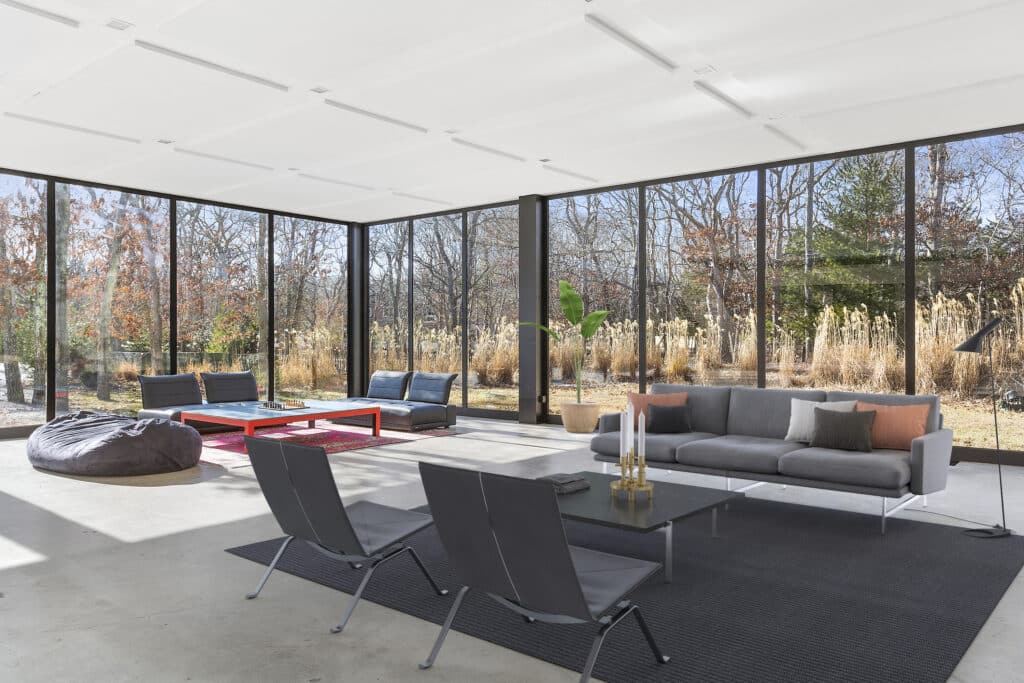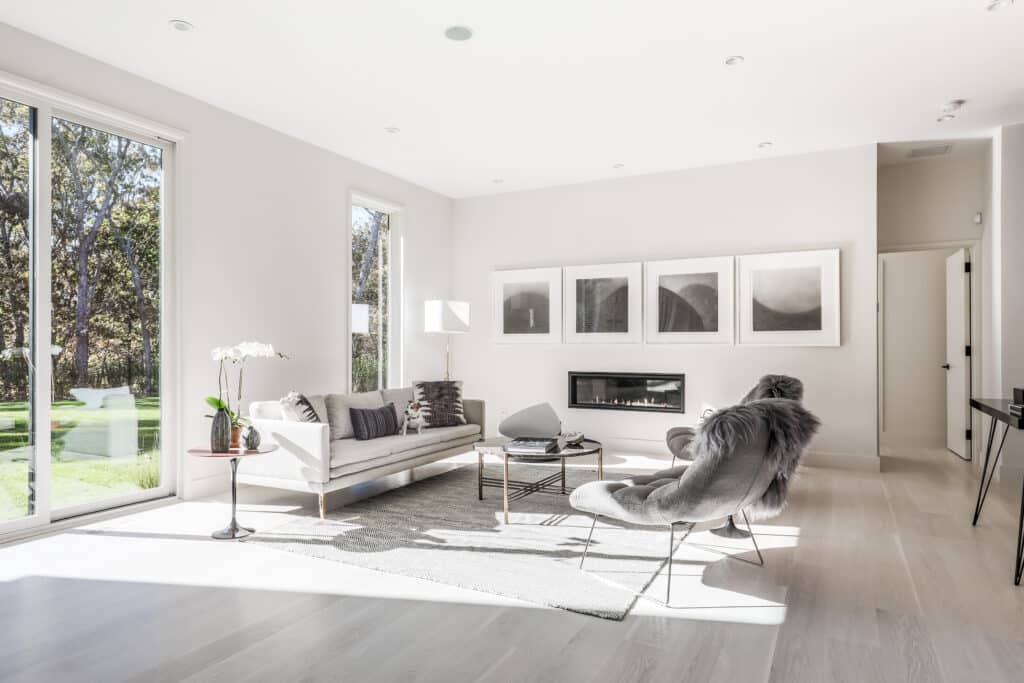When we think of the word “trend,” we envision quickly evolving and often short-lived fashions and designs that come and go. They make an enormous impact while they last, and disappear just as quickly. Minimalism, as a design trend, is not a quick flash in the pan. Instead, it is more about a way of life being expressed in a home or workspace.
At its heart, minimalism is the stripping away of all that is unnecessary to focus on simplicity, order, and natural beauty. The function is elevated to an art form, and a neutral palette is saved from starkness by incorporating natural materials such as stone flooring or sisal rugs. These natural elements serve a function while giving visual interest to space.
Sustainable architecture using natural materials is the foundation of the minimalist design trend fueled by deepening concerns over climate change. Though we consider it a modern movement, it is a timeless concept. Ancient civilizations made use of natural resources to funnel breezes through structures, and Pueblo dwellings were built under massive overhangs to take advantage of natural shade.

While minimalism tends to be eco-friendly, it is about more than easing the burden on our planet. Instead, minimalism, coupled with sustainable building practices, showcases a connection with the environment. Whether your space is a retreat from the cityscape around you, or your windows overlook ocean vistas, minimalist design showcases the natural world.
With a less is more focus, the view from a floor to ceiling window might become the showcase art of an entire room. Organic architecture focuses on blurring the lines between land and building. The minimalist design trend does not have to include organic architecture, but the two complement each other.
The formal definition for organic architecture comes from the Dictionary of Architecture and Construction: “A philosophy of architectural design, emerging in the early 20th century, asserting that in structure and appearance a building should be based on organic forms and should harmonize with its natural environment.”
Harmony with the natural world plays a significant role in minimalism. In a world where everything competes to stand out, minimalism embraces the notion of serenity and blending in with the natural surroundings. Minimalism is a lifestyle choice that offers an answer to the technology-driven, fast-paced, and often chaotic world in which we find ourselves immersed. Homes and workspaces that are free of clutter and distractions offer a retreat where one can recharge and relax.

Foundations of Minimalist Design
Simplicity and function are the primary design element
Natural floorings such as wood and stone combined with natural materials for countertops and furnishings
An abundance of natural light
A neutral color palette
A complete lack of clutter and everything has a place
A minimalist design is saved from starkness by creating a soothing and inviting space that is serene. Natural materials add a touch of warmth and visual interest without overwhelming the senses, and everything in the space serves a function. Minimalist design is not boring. Instead, it removes distractions and allows the focus of a room to remain on its intended use. Kitchens are highly functional spaces for cooking and gathering, and living areas invite comfortable lounging and conversation.
Ample storage is necessary to avoid clutter while providing a space for the necessities of life. A complete lack of clutter offers a relaxing atmosphere free of distractions. A well-designed minimalist space has a calming effect on its occupants, which plays a significant role in the ongoing popularity of the design trend.
The less is more philosophy means fewer material things to fill a space, making the space more eco-friendly. Quality over quantity means investing in timeless pieces that will not need replacing, reducing the consumption of resources. The focus on function reduces consumerism, encouraging the more careful use of resources.
Minimalist design has a wealth of practical purposes. It is easier to clean and maintain, which frees up time for more important pursuits. With fewer things in a space, dirt and clutter have nowhere to hide, meaning you are more likely to clean and put things away promptly. Having a clean space that is easy to maintain adds to the calming benefit of minimalism. Practicality, simplicity, and style are the hallmarks of minimalist design. The use of sustainable resources and natural building supplies pays tribute to the natural world and encourages a thoughtful focus on what matters most to the occupants.












!['The Maples' is a prestigious generational compound of two extraordinary estates: 18 Maple and 22 Maple. This rare offering, designed by luxury architect Lissoni partners New York and developed by visionaries Alessandro Zampedri-CFF Real Estate and JK Living, redefines opulence with the highest quality of craftsmanship and captivating views of the Atlantic Ocean. Represented by @nycsilversurfer and @challahbackgirl of @douglaselliman. [link in bio]](https://hamptonsrealestateshowcase.com/wp-content/uploads/sb-instagram-feed-images/438891010_1083749139481747_7890082604579275354_nfull.jpg)
![Featuring 360-degree water views on Mecox Bay, the Atlantic Ocean and Channel Pond, 1025 Flying Point offers the ultimate beach cottage that is flooded with natural light. With panoramic views, proximity to the ocean, and a private walkway to Mecox bay for kayaking or paddle boarding, this truly is a special retreat. Represented by @ritcheyhowe.realestate and @hollyhodderhamptons of @sothebysrealty. [link in bio]](https://hamptonsrealestateshowcase.com/wp-content/uploads/sb-instagram-feed-images/438994305_737511778456166_4602476013493875279_nfull.jpg)
![Attention advertisers! 📣 Secure your spot in the highly anticipated Memorial Day edition #HRES. Reach thousands of potential clients and showcase your brand in one of the most sought-after publications in the Hamptons, NYC, Palm Beach, and beyond. Contact us now to reserve your ad space! [link in bio]](https://hamptonsrealestateshowcase.com/wp-content/uploads/sb-instagram-feed-images/438549843_275102939023235_6718257301437562124_nfull.jpg)
![You eat with your eyes, and on the East End, it’s important that what you eat looks just as good as how it tastes. At @rosies.amagansett, the restaurant itself is plenty photo-worthy with blue ceramic tiling and yellow and white striped fabric wallpaper. But for a dish that will light up your photos, head directly to the salmon tartare! [link in bio]](https://hamptonsrealestateshowcase.com/wp-content/uploads/sb-instagram-feed-images/437094269_7296727147115953_1594410326824303644_nfull.jpg)

![We were honored to be the media sponsor for @blackmountaincapital's open house event with @jameskpeyton and @jfrangeskos at 11 Dering Lane in East Hampton! Other sponsors included @landrover, Feline Vodka, @rustikcakestudio, @la_parmigiana, @lahaciendamexicangrill11968, @homesteadwindows, Stone Castle, @talobuilders, and @thecorcorangroup.
A big thank you Carrie Brudner of Black Mountain Capital for putting together this fabulous event! [link in bio]](https://hamptonsrealestateshowcase.com/wp-content/uploads/sb-instagram-feed-images/437081213_762912965932136_6847332836522786568_nfull.jpg)

![Blooms Galore at the Long Island Tulip Festival! 🌷✨ Mark your calendars for April 15th as the vibrant tulips at @waterdrinkerlongisland burst into full bloom! Enjoy a day filled with colorful splendor, food trucks, live music, and more. [link in bio]](https://hamptonsrealestateshowcase.com/wp-content/uploads/sb-instagram-feed-images/437083429_974242677583725_6855805712693638343_nfull.jpg)
